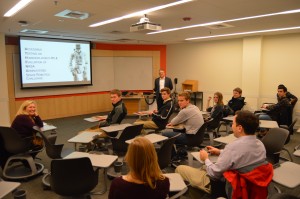Today, the Center for STEM Education, in conjunction with the College of Engineering, held it’s fall 2015 edition of Building Bridges. 91 students from 39 different schools in 7 states came to learn about various different engineering topics.
Rifat Sipahi taught a bioengineering activity, “Detecting Disease Through Handwriting,” in which students learned how to take an engineering approach to addressing problems due to hand tremors.
Rich Whalen taught a mechanical engineering activity, “Streamline an SUV,” in which students used the mechanical engineering wind tunnel to investigate the drag force on model sports utility
vehicles of different shapes.
Jose Martinez Lorenzo taught a mechanical engineering activity, “Sensing and Imaging Hidden Objects,” in which students used an mm-wave radar imaging system to find concealed objects under clothing.
David Kaeli taught an electrical/computer engineering activity, “Control a Robot Arm,” in which students learned about embedded systems and robot control by figuring out sets of commands to control a robot arm.
Yongmin Liu taught an electrical engineering activity, “Lost In the Dark?,” in which students designed and built a circuit of an electronic nightlight.
Randall Erb taught a mechanical engineering activity, “3D Printing,” in which students learned about 3D printing in the materials industry, printed out objects with a 3D printer and made their own objects through layer-by-layer manufacturing.
Taskin Padir taught a computer engineering activity, “Robots Everywhere,” in which students learned about different robots, like smart wheelchairs, space exploration rovers and humanoids for disaster response.
Phil Larese-Casanova taught an environmental engineering activity, “Water Treatment,” in which students learned how river water is converted to drinking water and conducted their own table-top treatment plant.
Loretta Fernandez taught an environmental engineering activity, “What’s in The Mix?,” in which students identified contaminants in a groundwater sample using thin-film chromatography.
Kaushik Chowdhury taught an electrical/computer engineering activity, “WiFi Egg Hunt,” in which students learned about signal strength and fading power relation to distance through the use of a smartphone to look for Wifi Access Points (eggs) throughout the Northeastern campus.
Jackie Griffin taught an industrial engineering activity, “Models for Malaria Prevention,” in which students developed a plan for the prevention of malaria in a developing country – and tested the performance of their plan using a tool similar to one developed by industrial engineering students for the World Health Organization.
Casper Harteveld taught an arts, media, and design activity, “Serious Game Design”, in which students learned about what “serious” games are all about. They found out how gaming can be applied to various STEM topics such as computer science, marine science, and scientific inquiry.
Mishac Yegian taught a civil/environmental engineering activity, “Designing Earthquake Resistant Buildings,” in which students explored the world of structural engineering. They saw how designing earth-quake proof structures is important to the safety of millions. They participated in small scale tower building and tested out their structures on the shake table.
The Center for STEM Education in combination with Northeastern student volunteers hosted a College 101 activity, during which students got a chance to ask engineering students anything about their college experiences!










